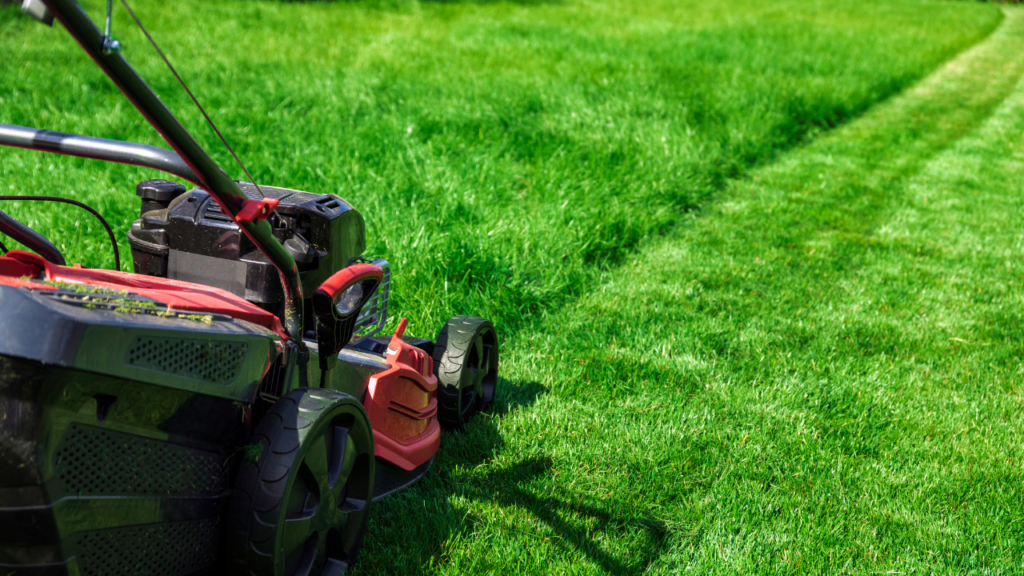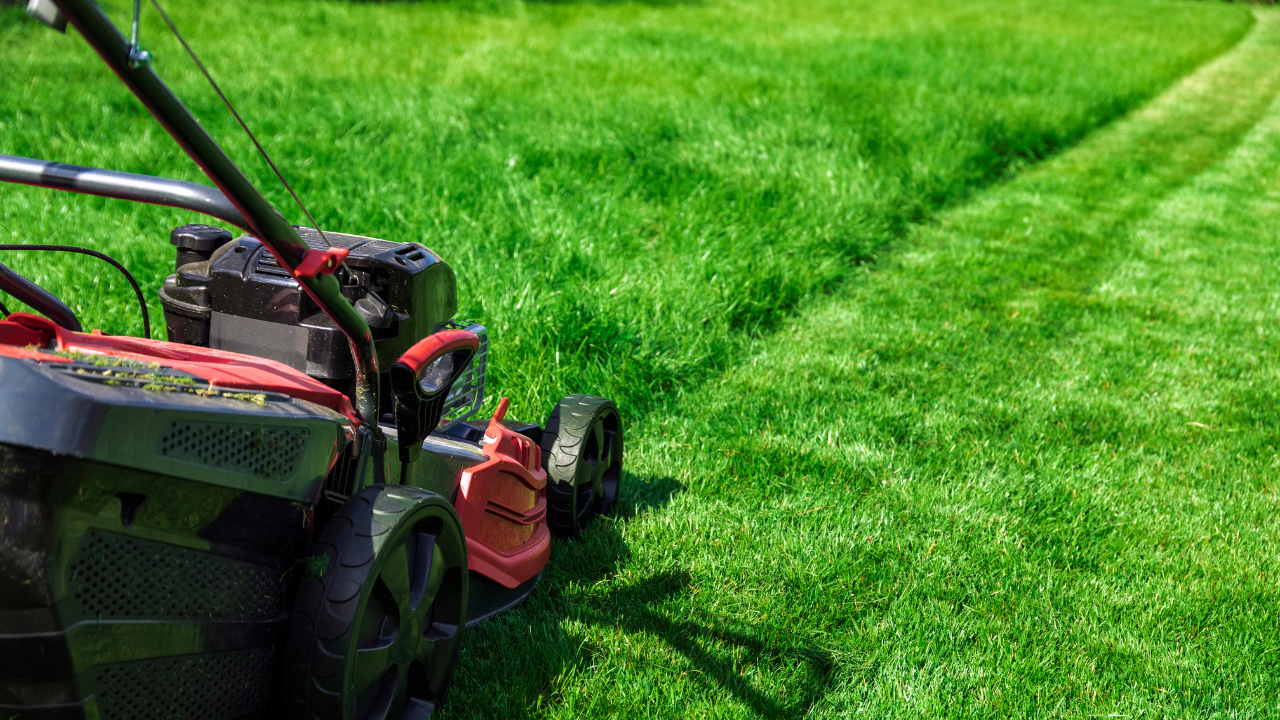
A green, lush lawn that’s in great health signifies that you are a responsible neighbour. Homeowners know that maintaining these open spaces requires knowledge, time, and money, so having a manicured lawn is a badge of honour!
But let’s be honest. Lawn care is challenging, especially if the blistering heat of summer has you sweating just thinking about it. Not only during summer, but there are also gardening problems during winter that affect your lawn care routine. Additionally, lawns require fertiliser, water, adequate sunlight, and yes, you guessed it – constant mowing.
So what exactly does it take to have a gorgeous lawn that will make your neighbours green with envy? We’ve compiled a list of the top 10 mowing tips from professionals so you can hack your way to that perfect lawn.
1.) Know your lawn’s grass type, shape, and topography
Different lawns require different types of care and mowing schedules. There are over 12,000 species of grass worldwide, and its health will depend on how you treat it along with other factors such as region, soil, foot traffic, and climate.
For example, the recommended mowing length for cool-season grass like Fescues and Bluegrass is 3-4 inches, while warm-season grass like Bermuda and St. Augustine should be mowed at 2-3 inches. Cutting at these heights ensures that your grass can photosynthesize properly and produce the food it needs to stay healthy.
Likewise, your lawn’s shape and topography will determine what kind of equipment you’ll need, which brings us to tip number 2.
2.) Choose the right lawn mowers
Now that you know a thing or two about various grass types and hopefully your own, it’s time to pick the right mower. Most homeowners will look at price, brand, and cool features when choosing a lawn mower. However, the most famous brands or expensive lawn mowers are seldom the best solution.
When choosing a mower, first think about the size and terrain of your lawn
According to professionals, the general rule is that a large lawn requires a bigger mower as it can cover more ground in a shorter amount of time. If your lawn has hills, slopes, or other types of challenging terrain, you’ll want to consider a lighter, more manoeuvrable mower which can adjust cutting heights. Alternatively, if you have a flat lawn, you can opt for push mowers or cylinder mowers.
Mowing can be tedious and laborious, especially when you’ve got ample space to cover. However, picking the right mower can make cutting your lawn seem pleasant and even therapeutic!
3.) It’s ok to double cut your blades
If you’re in the unfortunate scenario of having overgrown grass, a little bit of composure can go a long way. Instead of chopping everything down in one go with your lawn mower, take your time and cut the grass bit by bit. When you cut too much off, it can potentially inhibit the growth of your grass.
We instead suggest trimming your grass with half of the blade still intact, or 50% of its current height. You can then wait a few days and mow it again, taking another 50% off. And while a third time may be required if your grass resembles a jungle, this methodical approach will result in a much healthier, stronger lawn.
4.) Keep your mower’s blades sharp
This may be the most basic tip, but it’s right up there in terms of importance. A dull blade can tear the grass, causing them to turn yellow or brown. It also makes your grass susceptible to fungal diseases such as Leaf Spot (Helminthosporium), Dollar Spot (Sclerotinia Homoeocarpa) and Leaf Blight. And aesthetically, your lawn will end up looking a raggedy mess!
There are two options to avoid dull blades: Sharpen them yourself using a file, angle grinder, bench grinder, etc., or take them to a local lawn mower shop. Just make sure to have other sharp blades on hand, as you won’t always be able to pick up your blades the day you bring them in.
5.) Mow when your lawn is dry
It can be frustrating when the only time you’re free to mow your lawn is on or the day after rainfall. While it’s tempting to get to work, don’t let this time constraint pressure you into cutting your grass.
Moisture can weigh grass down, making the blades bend and difficult to cut. Furthermore, the wet clippings can damage your mower, and clumps can spread unevenly onto your lawn. This buildup eventually blocks sunlight and water from reaching the grass’ roots, stopping them from getting precious nutrients.
Wet grass clippings are also dangerous as you can potentially slip on them. Your best bet is to just be patient and wait for your wet lawn to dry.
6.) Don’t let your lawn grass grow too high
It’s easy to look at your beautiful green lawn and think that the taller, the better! However, don’t let this be an excuse to neglect your yard work and let the grass blades grow too high. Long grass prevents sunlight from entering the turf’s surface, causing lower portions of the grass blades to become prone to diseases, insect damage, and weeds.
Tall grass also poses major health risks (not the horror movie kind!). It can harbour all sorts of rodents and insects, and be a breeding ground for bugs, rats, and venomous snakes. Moreover, tall grass can easily hide debris and other objects you can inadvertently run over when you’re mowing.
So when your grass starts to look like it’s getting a little too shaggy, make sure to give it a trim.
7.) Mow in alternate patterns
No, we don’t mean get all artsy with your mower and start mowing in spirals or other patterns. Rather, we recommend varying your mowing patterns as mowing in one direction can cause grass to lean the same way. This ultimately takes up more space and prevents new blades from growing.
Going over the tracks repeatedly can also result in rutting and soil compaction, which prevents air circulation and makes it difficult for water to reach lawn roots. When in doubt, just go in a circle.
8.) Mow only when needed
The changing seasons can heavily affect your lawn. As such, you’ll need to mow more often during the growing season in early spring and autumn. We recommend mowing your lawn at least every 7-10 days if you’re using a rotary and at least every 3-5 days when using a cylinder mower.
In summer or at the end of the growing season, you can reduce your mowing frequency to every two weeks if you’re using a rotary and weekly if you have a cylinder mower.
However, there is no perfect, set schedule for mowing, nor a one size fits all answer The key is to just keep an eye on your lawn and be attentive and understand your lawn’s growing conditions.
9.) Wear protective equipment
Mowing can be hazardous when done incorrectly, causing serious injuries like lacerations, concussions, and even amputations. One of the best ways to minimise the risk of injuries is by simply wearing proper personal protective equipment (PPE).
Here are some essential PPE to have when operating a lawn mower:
- Long, close-fitting thick pants
- Closed-toed, non-slip shoes
- Safety glasses or goggles
- Ear muffs/plugs
- Safety gloves
When you’ve concluded your lawn mowing session, make sure to clean and store your PPE properly. While wearing the appropriate PPE is always necessary, maintaining them in good condition is also essential in ensuring your safety.
10.) Mulching over bagging
Mulching and bagging both have pros and cons, but if you ask our professionals, they would recommend mulching the grass clippings and returning them to the lawn. This is oftentimes called “grasscycling,” as it provides nutrients and helps retain soil moisture.
Mulch is a natural fertiliser. By spreading it on the lawn, you return its much-needed nutrients to the ground and reduce garbage in the landfill.
Although mulching is viable, there may be times when you’ll have to bag your lawn clippings. This happens when the grass is too tall, and the clippings may cover the grass and prevent nutrients from infiltrating the soil. Bagging is also more helpful if your lawn shows signs of disease and you want to avoid it from spreading.
Bonus Tip: Consider Lawn Edging for a Polished Look
While mowing is essential for maintaining a healthy lawn, edging can give your lawn that polished, professional finish. Lawn edging creates a defined boundary between your lawn and other areas, such as flower beds, driveways, or pathways. Not only does it enhance the aesthetic appeal of your garden, but it also prevents grass from growing into unwanted areas. If you’re interested in exploring the benefits of lawn edging and how it can elevate the look of your outdoor space.
Final thoughts on lawn mowing tips
Lawn mowing is a necessary evil to achieve the perfect lawn. No one said it was going to be easy, but with the proper techniques and key information, you can make it quicker and easier.
By following the tips we’ve discussed in this guide, you can take better care of your lawn while minimising the time you spend mowing it. Of course, these are just some general tips and if you’re ever in doubt, it’s best just to let the professionals handle it. At the end of the day, it’s still your lawn and you should do whatever you think is best for it.
Sidepost offers quality lawn mowing services in Sydney, Hobart, Canberra, Gold Coast, Adelaide, Perth, Brisbane, Melbourne, and all across Australia. If would like to make a booking, just contact us at 1300 138 499.
Air Conditioning ( 3 )
Blinds installation ( 3 )
Building and Pest Inspections ( 4 )
Car Detailing & Car Wash ( 3 )
Carpet Cleaning ( 3 )
Carpet Installation ( 2 )
Custom Fish Tanks ( 2 )
Dry cleaning and ironing ( 3 )
Fencing Contractors ( 5 )
House Cleaning ( 7 )
House Painting ( 6 )
Ironing Service ( 1 )
Lawn Mowing ( 3 )
Pest control ( 2 )
Pool cleaning/servicing ( 3 )
Pressure Washing ( 2 )
Uncategorized ( 6 )
Professional Home Services at your Door
Get it all done with Sidepost - House cleaning, fencing, painting, and more.

